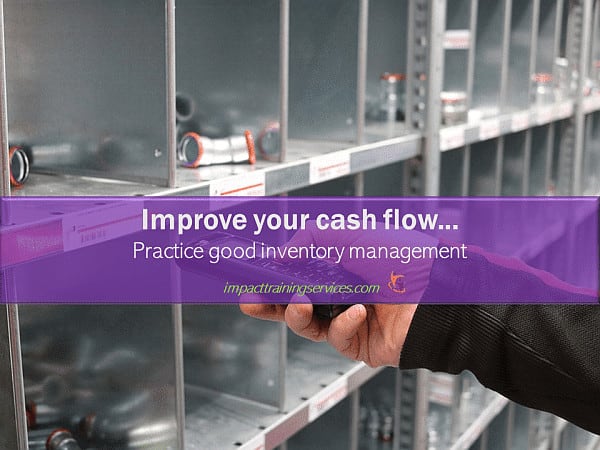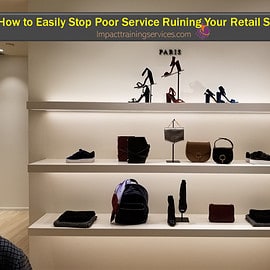Last Updated on April 14, 2024 by Lorna Barrow

Cash Flow…When you think of it, what comes to mind?
Simply put, cash flow is the amount of money flowing into your business (revenue/sales) and flowing out (expenses) each month.
If you have more money coming in than going out, your cash flow is positive and you’re happy. If it’s the other way around, it’s negative and you feel incompetent and stressed.
We all know that having more cash coming in than you’re paying out is essential to any business. But what is not much talked about, is if you’re in retail, it is even more important. Why? Because your inventory is the life of your business and it also can cost a lot of money.
It follows then, that one of the best ways to maintain a positive cash flow, is to control your inventory.
And that’s where I want to focus your attention with this post.
I want to show you how you can constantly have a positive cash flow, by deliberately controlling your inventory for this purpose.
So if you’re ready…here they are: 6 easy ways to control your inventory to keep your cash flow positive. And they don’t even require you to put out any extra money.
1. Understand the relationship between inventory and cash flow
Inventory or stock is usually the largest purchase you will make. Therefore, you want to sell it off as fast as you can. If you don’t do this, you are actually tying up cash you need to spend in other areas of the business.
And if that’s not enough, even in retail, you will meet the 80-20 rule or pareto analysis.
This means that 80% of your sales is generated by 20% of your stock. At first you could find yourself celebrating this. Until you realise, that the remaining 80% of your stock is generating only 20% of the sales!
Let’s really understand this.
It means that 80% of your inventory is remaining much too long on shelves in your store or in your storerooms. Even more concerning, that 80% of stock on hand also represents 80% of the cash you you invested in stock.
In other words, if you spend $100,000 in stock and $20,000 (20%) is used to generate sales, then $80,000 worth (80%) is now hanging around, waiting to generate $20,000 in sales.
And if you borrowed for that inventory, the longer it stays on the shelf, the more likely to you are to default on the debt. And the more likely you are to feel like a loser.
The important question then, is how did this happen in the first place?
The answer to this is in my next tip…
2. Avoid assortment creep
A significant cause of the problem of having large amount of slow moving stock on hand, is something called assortment creep.
According to business know-how, assortment creep is the slow, steady, almost imperceptible addition of items and categories to existing merchandise and product assortments, which adds to inventory levels, but not significantly to sales, thus tying up valuable cash and diluting overall inventory productivity.
In other (simple) words, assortment creep, is really your own desire to be everything to everybody or trying to offer every possible product that your customer might want.
At the foundation of this is a feeling, born out of your insecurity, that because you’re small, you must sell a little of everything to attract and keep more customers.
At this point, you completely forget that you could unlock more of your revenue with great customer service and rewarding your staff for exceptional performance.
A better approach would be to…
3. Develop a purchasing plan to protect your cash flow

A good purchasing plan requires you to be clear about your niche or market segment.
I’m sure you’ve heard this before. But what nobody tells you is how hard it is when you’re small and want to make money fast. When this is the case, you want to serve any and every body. Resist this.
Then you need to identify your key customers and their buying habits. You can easily get this information from you point-of sale reports or your well-designed loyalty programme, if you have one.
Having established your sales targets for a particular period (you did, didn’t you?) you are now ready to “buy smart”. But before you build up your inventory, be sure that your forecast is realistic and based on sound data.
In this way, when you buy stock, you spend more on those items which are more closely aligned with the need of your customers, and will move faster.
You can also support this approach by carefully selecting your other items from the 6 categories of items which every retail business must sell namely:
- Destination Merchandise
- Image Enhancers
- Transaction Builders
- Traffic Builders
- Profit Generators
- Turf Protectors
(If you want, I can write you a post on this. just let me know.)
This will help your stock to move faster, help you achieve your sales targets, keep your customers coming back and reduce the amount of cash you have tied up in inventory. And of course improve your cash flow.
If you still end up buying too many of the wrong item, then you can…
4. Reduce the level of inventory on hand
Some store owners hold on to slow or “non-moving” stock like some of us hold on to bad relationships.
Mind you, I totally get it. You probably bought some of those items with lots of love in your little heart or because your partner liked them. Or, 2 out of your 200 customers asked if you carry them.
If you’re guilty of assortment creep, however you acquired the inventory, you end up with quite a bit of old, outdated, unpopular or dust-gathering stock. And you’ve just got to get rid of it.
The best way to do this is to hold a sale and send these items packing.
Not a “joke” sale but a real “ring-down” sale with prices slashed low enough to entice customers to buy. Not only does this increase your cash flow quickly, it’s a great way to keep your regular customers.
Nothing drive your customers into the the hands of your ecstatic competition like regularly coming into your store and seeing the same old stock .
You also need to…
5. Layout your store to impact your cash flow
Yeah…I mean that.
Many of you do not readily make the connection between how you layout the products in your stores and the impact on cash flow.
Walmart founder Sam Walton firmly believed that your store’s physical environment affects the ways in which shoppers interact with your merchandise, and that this ultimately affects how much money your customers spend.
Admittedly, a discussion on this would require a post on its own but here are two examples to get you thinking.
Research shows that there’s a natural inclination in which most customers physically move through a store as they shop.
They are inclined to move counter clockwise or to their left, when they come through the door. For you, the small business retailer, this means that the space just to the right of the door is always premium “sales estate.”
Think about it. This is the space where you should display your fast-moving, high-profit items. If you’re in hardware for example, this space will be WASTED on paper rolls and kitchen towels!
On the other hand, you want to place your essentials as far from the door as possible. Ideally in the back of the store.
You want to use this approach to do 2 things. (1) Increase the time customers spend in the store and (2) encourage them to cover as much ground as possible.
The more ground they have to cover to reach their desired items, the more time they will spend in store. In a carefully laid out store, there will be select items place in their path, to tempt them into spending more.
And don’t forget to…
6. Practice good inventory management

Managing your inventory does include monitoring and controlling the movement of items through your system. This is mostly achieved through the point-of-sale, annual stock counts and all the other obvious thing that you do.
But a really important aspect of effective inventory management is to improve your stock turn. Your stock turn or inventory turnover is the rate at which inventory is sold in a particular time period, mostly a year.
Keeping it simple for you:
The stock/inventory turn ratio is the cost of good sold (COGS) or cost of sales (COS) divided by average inventory. Average inventory is the inventory at the beginning of your financial period added to the inventory at the end of the same period, divided by 2.
Putting some numbers on that:
Cost of sales = $150,000
Opening stock = $20,000
Closing stock = $30,000
Average stock = (30,000+20,000)/2 = $25,000
Stock turn = 150,000/25,000 = 6 times in a year
This number does not mean much on its own. It is more meaningful to compare it with what is standard for your market segment or industry.
You also want to be reviewing your monthly stock movement reports to spot buying trends of your customers. Being able to read evolving changes in your niches improves your buying decisions and of course, your cash flow.
In recent times, COVID-19 has raised stock management to the level of an Olympic sport. With supply chain issues affecting the availability of many items, how much of which items to stock is a serious logistical challenges.
Another inventory challenge you will face that you should plan for is pilfering. This is petty stealing, mostly done by your employees.
A good way to control this is by controlling access to inventory. By having just a few handpicked employees accessing inventory, you improve control and reduce pilferage.
Your next “cash flow” step…
I know you now have a much better understanding of the impact of inventory on your cash flow.
What’s more, you also have 6 easy ways you can manage your inventory so that your cashflow is mostly positive.
It’s now entirely up to you to implement them and keep more money in your bank account. Or ignore them, and have to hide from your bank manager when she calls about your overdraft.
Just remember that understanding and managing your inventory is critical to your cash flow and, ultimately, to your company’s sustainability.
To success with your positive cash flow management…


